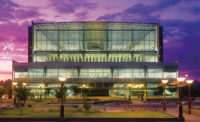AIA Honor Award 2010: 25 Year Award - Hajj Terminal

Hajj Terminal
The scale of the massive, 100-acre terminal is indicated by the size of the aircraft in relation to the building. The fiberglass cones are 110 feet high at their peak and are supported through a system of interconnected steel tension cables. The tapered steel pylons are each 150 feet high.
Photo © Jane Smith

Hajj Terminal
The scale of the massive, 100-acre terminal is indicated by the size of the aircraft in relation to the building. The fiberglass cones are 110 feet high at their peak and are supported through a system of interconnected steel tension cables. The tapered steel pylons are each 150 feet high.
Photo © Jane Smith

Hajj Terminal
The interior of the structure is characterized by a series of long, open-plan spaces, with customs and administration near the edges.
Photo © Jane Smith

Hajj Terminal
Image courtesy Skidmore, Owings & Merrill


Post a comment to this article
Report Abusive Comment